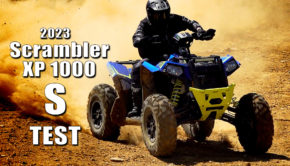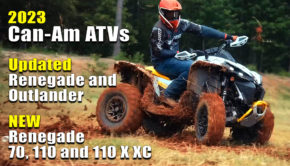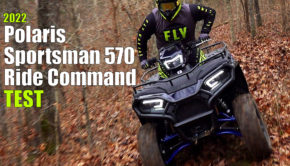2011 125cc Sport ATV Shootout.
The 125cc sport ATV class is a small, yet very important, part of the market. While there may be others out there, Pitster Pro’s FXR125 and Yamaha’s Raptor 125 are the two main players in a class that provides the next step for young riders who have outgrown their 90cc machines, allows for more classes in youth ATV racing, and, most importantly, will introduce many new riders to the fun of ATVing.
Having already track and trail tested both the Raptor 125 and Pitster Pro FXR125R, we can attest that both are capable performers, and each excels in its own way. The Yamaha was designed as a good, all-around, sport ATV, while the Pitster Pro was designed more as a low-tech, out-of-the-box race machine. Making this comparison even more interesting, both machines share an identical retail price of $3,399 leaving us to compare rider preference, performance, and durability.
Technical Breakdown
Both machines have 124cc, air-cooled, two-valve, single overhead cam, four-stroke engines. The Pitster Pro’s engine is a horizontal design, while the Yamaha’s cylinder is vertically mounted. A 22mm carburetor feeds the FXR125, while a 29mm Mikuni feeds the Raptor. Kick starting fires up the Pitster, while the Yamaha features push button electric starting. Both ATVs feature manual shift transmissions. The Raptor features a five-speed design with a one down, four up gear pattern. The FXR utilizes a close ratio, four-speed gearbox with neutral at the bottom of the pattern.
The Pitster Pro features a beefy looking chromoly frame, camber and caster adjustable chromoly A-arms, and a lightweight aluminum swingarm.
The Raptor features a mild steel frame, with a non-adjustable dual A-arm front end, and rear swingarm. Both machines feature easy-to-use eccentric chain adjustment.

The Pitster Pro features a beefy looking chromoly frame, plus piggyback reservoir-equipped shocks front and rear.
The Pitster is outfitted with piggyback reservoir-equipped shocks front and rear. The shocks feature preload, compression, and rebound adjustment and control 8 inches of travel up front, 9 out back. The Raptor features five-way, preload-adjustable shocks controlling 7.5 inches of front travel, and 7.9 at the rear.
Both machines feature individually operated front and rear hydraulic disc brakes. The feature-packed FXR features dual piston front calipers, steel braided brake lines, and a wave style rear rotor. The FXR also features a uniquely designed reverse-facing brake pedal.
On the Pitster Pro, traction is provided by 19x6x10 front and 18×6.5×8 rear, Carlisle tires. The Carlisle’s are wrapped around lightweight aluminum rims. These tires were the industry standard in youth racing for years. The Raptor’s 19x6x10 front and 18x9x8 rear Maxxis tires were created specifically for the 125. They are quickly becoming the new standard in youth ATV racing, especially for 90cc and above machines. While both rear tires are identical in listed diameter, the Yamaha’s Maxxis are actually over an inch taller, plus notably wider. Yamaha outfitted the Raptor with a set of light aluminum wheels.

The Raptor features a mild steel frame, dual A-arm front end, and rear swingarm. The Raptor’s Maxxis tires are quickly becoming the new standard in youth ATV racing,
The Yamaha comes with plastic chassis and swingarm skid plates, a small lightweight front bumper, and the normal footpeg and heel guard setup. The Pitster Pro features a full-length chassis skid plate. The swingarm features round aluminum sprocket guard and separate rotor guard. The Pitster Pro comes with nerf bars and heel guards. Our dealer removed the heel guards prior to our picking up the machine. Due to their awkward hinged design, the heel guards have to be flipped up to kick-start the engine.
The FXR measures in at 45 inches in width; five inches wider than the 40 inch wide Yamaha. The Yamaha has a 43.7 inch wheelbase, compared to the Pitster at 43 inches. The Yamaha has a 28.1 inch seat height while the Pitster sits a bit higher at 29 inches. At 244 pounds wet, the Pitster Pro is 55 pounds lighter than the 299-pound Raptor.
The Shootout.
Our riders consisted of 17-year-old former two-time 90cc National Champion, Alex Kersey; 300cc four-stroke motocross racer, Justin Flaugher; and 85cc and women’s class dirt bike racer, Melanie Strode.
Our shootout took place at Big Rock Off-Road Park and Earlywine’s Indoor Motocross, both located in Maysville, KY. We laid out a small cross country loop at Big Rock, which consisted of several high speed straights, several decant climbs with a challenging rocky section, and one long descant. At Earlywine’s, our riders put the 125s to the test on their indoor track, then rated each machine in detail. There, we also ran timed motos as the ultimate test of performance.
Engine Performance

The Pitster produced a bit more bottom, and notably more midrange power, easily pulling the Raptor on long hills and holeshots.
The Pitster Pro wins the engine category in terms of all-out power. It’s notably louder and freer flowing exhaust aids the FXR in producing a broad, strong powerband. The Pitster produced a bit more bottom, and notably more midrange power, easily pulling the Raptor on long hills and holeshots. In top-end power, the Pitster tied with the Yamaha. It is possible that its top-end rating has more to do with the transmission’s gear ratios than actual high RPM power.
When it came to transmission performance, the Pitster gave up some ground. Although it could easily pull a high gear, the spacing of close ratio four-speed made finding the ideal gear more difficult, as we discovered in the rhythm section at Earlywine’s. It took a bit more effort to click through the gears. One rider noted that, “…having neutral at the bottom of the shifting pattern is hard to get used to.”

Good power and superb shifting were enough to allow the Raptor to sneak past the Pitster Pro in the engine department.
The Pitster’s engine tied the Yamaha in overall effectiveness and a good five-speed transmission would have put it over the top. As it is, the FXR gives up around four tenths of a point to the Raptor in overall engine ratings.
The Raptor’s engine is strong and smooth, pulling well throughout the RPM range. It has good low-end torque, a smooth seamless midrange, and you can rev the guts out of it. It will hang with the Pitster Pro, but gives up some midrange torque in trade for a quieter, yet more restrictive, exhaust.
The Raptor’s gearbox is typical Yamaha. The five-speed transmission shifts smoothly, its gear rations are well-spaced for all types of riding, and clutch pull is light and smooth.
Good power and superb shifting were enough to allow the Raptor to sneak past the Pitster Pro in the engine department.
Pitster Pro FXR125R |
Yamaha Raptor 125 |
| Engine Performance | 7.89 | Engine Performance | 8.28 | |
| Low-End Power | 8.66 | Low-End Power | 8.33 | |
| Mid-Range Power | 8 | Mid-Range Power | 6.67 | |
| Top-End Power | 7.33 | Top-End Power | 7.33 | |
| Shifting Smoothness | 6.66 | Shifting Smoothness | 9.66 | |
| Clutch Ease | 8.33 | Clutch Ease | 9.33 | |
| Ride-Ability | 8.33 | Ride-Ability | 8.33 |
Handling Performance

With its extra width and small tires, the race-ready Pitster Pro excels in both cornering and high-speed stability.
With its extra width and small tires, the race-ready Pitster Pro excels in both cornering and high-speed stability. Our riders noticed the front end’s tendency to push on tight turns, so we backed all of the caster out of the adjustable front end, which helped somewhat. The FXR still prefers to be steered with the rear wheels, at times, and is a predictable slider.
The Pitster Pro gave up a bit in both weight feeling and weight balance ratings. Melanie actually scored the Pitster two points lower than the Raptor for weight feeling. The Pitster Pro is lighter than the Raptor, but it doesn’t feel that way.

The Raptor is a stable and very predictable handling ATV. It goes where it is pointed in turns, regardless of which line you choose.
The lighter feeling, more predictable steering Raptor surpasses the Pitster by nine tenths of a point. The Raptor is a stable and very predictable handling ATV. It goes where it is pointed in turns, regardless of which line you choose. The 125’s chassis was originally developed for the Raptor 250 so cornering and high speed stability are very good, but its taller tires and narrower stance allow for a bit more body roll than the Pitster.
Pitster Pro FXR125R |
Yamaha Raptor 125 |
| Handling | 8.1 | Handling | 9 | |
| Cornering Stability | 9 | Cornering Stability | 8.33 | |
| Steering Precision | 7 | Steering Precision | 9.33 | |
| High Speed Stability | 9 | High Speed Stability | 8.66 | |
| Weight Feeling | 7.33 | Weight Feeling | 9.33 | |
| Weight Balance | 8 | Weight Balance | 9.33 |
Suspension Performance
Yamaha did a superb job of finding a good, all-around setting for the Raptor’s minimally adjustable suspension. Its larger tires, which roll over small obstacles more easily, aid the Raptor’s suspension in providing the plushest ride over rocks, roots, and small bumps.
Fast trail riding and forgiving jumps are no problem for the Raptor’s shocks; however, once you start pre-jumping doubles or come up short, the heavier you are, the more the Raptor will find the limits of its suspension. Lighter or less experienced riders can tackle whoops easily, but heavier and more aggressive riders will have to back off as the Raptor’s rear end begins kicking a bit. The Raptor’s suspension is good, but its lack of adjustability hurt it in comparison to the Pitster.
The only segment of suspension where the Pitster fell behind the Raptor was in small bumps. The Pitster’s shocks are actually quite plush; however, its shorter, narrower tires make the ride rougher over trail junk.
The adjustability of the FXR’s shocks was a huge asset. It was good that the shocks were so adjustable, as they took some work to get dialed in. On jump landings, the shocks rarely found their limits, and our riders were charging the whoops notably harder on the Pitster.
Pitster Pro FXR125R |
Yamaha Raptor 125 |
| Suspension | 8.34 | Suspension | 7.17 | |
| Small Bumps | 7.67 | Small Bumps | 8.66 | |
| Whoops | 8 | Whoops | 7 | |
| Jump Landings | 8.67 | Jump Landings | 8 | |
| Tune-Ability | 9 | Tune-Ability | 5 |
Braking Performance
There were no split decisions when it came to brakes. The Pitster Pro’s rear brake worked well, but one rider found the rear pedal hard to reach. In spite of steel-braided lines and dual-piston calipers, the Pitster’s front brakes felt soft. We tried bleeding them several times with minimal success.
It took less effort to slow the Raptor or bring it to a halt. Its brakes offered superb feel and very good power at both ends.
Pitster Pro FXR125R |
Yamaha Raptor 125 |
| Brakes | 7 | Brakes | 9.83 | |
| Brakes Front | 6.33 | Brakes Front | 9.66 | |
| Brakes Rear | 7.67 | Brakes Rear | 10 |
Fit and Finish
Fit and Finish are often the first thing to suffer when dealing with a smaller manufacturer. The Pitster Pro’s ergonomics are a bit confused. A tall stem suits taller riders better, but the footpegs are far forward for riders of any size. The Pitster needs electric starting, or a redesign to its kick starter that would allow for the use of a conventional heel guard design. Vibration was also more pronounced on the FXR.

The Pitster Pro’s tall stem suits taller riders better, but the footpegs are far forward for riders of any size.
The Yamaha’s fit and finish ooze quality. The Raptor has well-spaced ergonomics with a very comfortable seat. Its controls feel perfectly shaped and work flawlessly. With a counterbalanced engine, vibration wasn’t an issue.
Pitster Pro FXR125R |
Yamaha Raptor 125 |
| Fit and Finish | 7.78 | Fit and Finish | 9.44 | |
| Ergonomics | 7.67 | Ergonomics | 9.66 | |
| Control Operation | 8 | Control Operation | 9.66 | |
| Lack of Vibration | 7.67 | Lack of Vibration | 9 |
Overall Ratings
After combining the rider ratings, the Raptor comes out on top. The Pitster Pro certainly shines in many areas of performance; however, it seemed that the overall refinement and comfort of the Raptor 125 made it the overall favorite with our riders.
Pitster Pro FXR125R |
7.82 |
Yamaha Raptor 125 |
8.74 |
Lap Times
At Earlywine’s, we had all three of our riders run two-lap motos on each machine with a gate drop start. The Pitster looked faster everywhere on the track. The Pitster dominated holeshots, could carry more corner speed, and could be pushed harder in the whoops. All three riders were over two seconds faster on the FXR125.
To be fair, had we run lap times on our trail loop, results may have been different. While the Pitster had the advantage on unobstructed climbs due to its lighter weight and less restricted engine, the Raptor was much easier to negotiate challenging rocky climbs with, thanks to its more accurate steering, narrower stance, plus the extra ground clearance and traction provided by its Maxis tires.
Pitster Pro FXR125R |
Yamaha Raptor 125 |
||
| Justin | 1:35:8 | 1:38:0 | |
| Melanie | 1:35:8 | 1:40:0 | |
| Alex | 1:22:04 | 1:24:57 |
Durability
After individual testing, followed by a head to head shootout, we are happy to report no major failures from either ATV. The Pitster Pro’s rubber front A- arm bushings broke down to the point that they fell off. This left the front upper A-arms with a notable amount of flex. The sprocket guard looked as though someone had beaten its edges with a hammer thanks to the rocks at Big Rock. The hammered guard never impeded chain movement and continues to function properly; it’s pretty tough. From the moment we received it from the dealer, the Pitster Pro’s engine made notably more valve noise than the Raptor. We had checked the valves several times and everything looked fine.
The Raptor came through with only minor scratches, with the exception of its swingarm skid plate. In spite of having more ground clearance, the Plastic skid plate couldn’t hold up to the brutal rocks. A-arm bushings are a bit more important than a swingarm skid plate, and Yamaha’s dealer network makes parts easier to come by. The edge in durability goes to the Raptor.
The Conclusion.
If this were a rider’s choice shootout, the Raptor would have clearly won. It swept in total average rider ratings and won every performance category except suspension performance. The Raptor is simply a more refined machine in almost every way, proving lots of small details are a huge deal.
Lap times don’t lie, though. The Pitster Pro outshined the Raptor in terms of performance, regardless of rider size, weight, or skill level. It’s faster around a motocross track and could be a capable youth woods racer or trail machine by switching to a wheel and tire setup more like the Raptor’s.
This story could change by modifying either machine, but we are comparing two stock machines. For $3,399 you have two choices, get a bit more performance and race-ready features with the Pitster Pro FXR125R, or a more refined and supported Yamaha Raptor 125. Both machines are great in their own way. Picking a winner–– that’s up to you!
Learn more about the Yamaha Raptor 125 at yamaha-motor.com.
Learn more about the Pitster Pro FXR125R at pitsterpro.com.




















